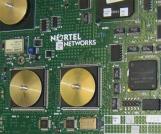27
OC-3 Express fibre optic carrier supports three video channels. A video channel can be replaced by 672 voice channels all on a single hair thin fibre. The OC-3 is designed to serve businesses and small communities. Systems such as the OC-192 support 192 video signals or if only used for voice it can transport over 129,000 circuits. Since optical carriers use light as a transmission medium, different colours (wavelengths) can be used, up to 160 wavelengths would carry nearly 31, 000 video channels or 20.6 million voice conversations on a single glass fibre.As with any signal transmitted over distance it loses its strength, it must be amplified without distorting the multiple 10 gigabit signals. This signal is produced by a laser generating 10 billion pulses a second. Soliton note wave technology extends the reach of optical amplifiers so that only a few are needed to cross the continent. Prior to the availability of optical amplifiers, the light wave had to be decoded, regenerated and transformed into a new light signal every 40 km. The high capacity networks of today are the reason for the lowering of the cost of toll calls. Compare the cost of a call to Europe via radio link at $25 a minute to today's cost of less 5 cents a minute.
Note: A soliton is a solitary optical pulse that propagates itself without distotion in nonlinear and non dispersive optical fibre. Defintion courtesy of Futura-science.com.
29
This printed circuit board used to transmit a 10 gigabit optical signal contains chips that have over 100,000 transistors. The board has 16 different conductor layers with paths much finer than hairs. Compare this to the earlier circuit board of the 1960s.Communications have come a long way from shouting into a wooden box to today, it is mind boggling! What will the future bring? Implants that will allow communications everywhere?
